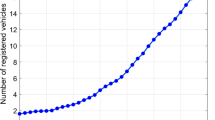Abstract
Accurate forecasting of vehicular consumption is a task of primary importance for several applications. Herein, a vehicular consumption prediction model is proposed, with special emphasis on robustness and reliability. Both features are enabled due to the selection of general regression neural networks (GRNNs) for the implementation of the proposed model. GRNNs are widely used among neural networks because of their capabilities for fast learning and successful convergence to the solution. In particular, the designed GRNN is responsible for approximating the nonlinearities and the specificities between the factors identified as major contributors in vehicular consumption. In order to evaluate its efficiency, a case study involving the application of the introduced model in fully electric vehicles (FEVs) is examined. The performance of the proposed model is successfully validated using real measurements collected during a data acquisition field campaign.









Similar content being viewed by others
References
Ahn K, Rakha H (2008) The effects of route choice decisions on vehicle energy consumption and emissions. Transp Res Part D Transp Environ 13(3):151–167
Ahn K, Rakha H, Trani A, Van Aerde M (2002) Estimating vehicle fuel consumption and emissions based on instantaneous speed and acceleration levels. J Transp Eng 128(2):182–190
Ben Dhaou I (2011) Fuel estimation model for ECO-driving and ECO-routing. In: IEEE intelligent vehicles symposium (IV). doi:10.1109/IVS.2011.5940399
Boriboonsomsin K, Barth MJ, Zhu W, Vu A (2012) Eco-routing navigation system based on multisource historical and real-time traffic information. IEEE Trans Intell Transp Syst 13(4):1694–1704
Brooker A, Haraldsson K, Hendricks T, Johnson V, Kelly K, Kramer B, Markel T, O’Keefe M, Sprik S, Wipke K, Zolot M (2003) ADVISOR Documentation. http://bigladdersoftware.com/advisor/docs/-advisor_doc.html. Accessed 14 Jan 2014
EPA (2003) Users guide to mobile6, mobile source emission factor model. http://www.epa.gov/otaq/models/mobile6/-420r03010.pdf. Accessed 14 Jan 2014
Jianming H, Qiang M, Qi W, Jiajie Z, Yi Z (2012) Traffic congestion identification based on image processing. IET Intell Transp Syst 6(2):153–160
Kamal MAS, Mukai M, Murata J, Kawabe T (2011) Ecological vehicle control on roads with up-down slopes. IEEE Trans Intell Transp Syst 12(3):783–794
Kara Togun N, Baysec S (2010) Prediction of torque and specific fuel consumption of a gasoline engine by using artificial neural networks. Appl Energy 87(1):349–355
Ki YK (2011) Speed-measurement model utilising embedded triple-loop sensors. IET Intell Transp Syst 5(1):32–37
Minett CF, Salomons AM, Daamen W, Van Arem B, Kuijpers S (2011) Eco-routing: comparing the fuel consumption of different routes between an origin and destination using field test speed profiles and synthetic speed profiles. In: IEEE forum on integrated and sustainable transportation, system (FISTS). doi:10.1109/FISTS.2011.5973621
Olden JD, Joy MK, Death RG (2004) An accurate comparison of methods for quantifying variable importance in artificial neural networks using simulated data. Ecol Modell 178(34):389–397
Pachernegg S (1969) A Closer Look at the Willans-Line. SAE Technical Paper 104271/690182
Pininfarina (2013) Pininfarina Nido EV. http://www.pininfarina.com/en/nido_ev. Accessed 14 Jan 2014
Rumelhart DE, Hinton GE, Williams RJ (1986) Learning representations by back-propagating errors. Nature 323(6088):533–536
SAE (2012) Electric vehicle energy consumption and range test procedure. http://standards.sae.org/j1634_201210/. Accessed 14 Jan 2014
Scardi M, Harding LW Jr (1999) Developing an empirical model of phytoplankton primary production: a neural network case study. Ecol Modell 120(23):213–223
Scora G, Barth M (2006) Comprehensive modal emissions model (CMEM) user’s guide, version 3.01. http://www.cert.ucr.edu/cmem/docs/-CMEM_User_Guide_v3.01d.pdf. Accessed 14 Jan 2014
Silva CM, Farias TL, Frey HC, Rouphail NM (2006) Evaluation of numerical models for simulation of real-world hot-stabilized fuel consumption and emissions of gasoline light-duty vehicles. Transp Res Part D Transp Environ 11(5):377–385
Specht DF (1991) A general regression neural network. IEEE Trans Neural Netw 2(6):568–576
Uzun A (2012) A parametric study for specific fuel consumption of an intercooled diesel engine using a neural network. Fuel 93:189–199
Vector (2013) Vector Box VN1610 device. http://vector.com/vi_vn1600_en.html. Accessed 14 Jan 2014
Wu JD, Liu JC (2011) Development of a predictive system for car fuel consumption using an artificial neural network. Expert Syst Appl 38(5):4967–4971
Wu JD, Liu JC (2012) A forecasting system for car fuel consumption using a radial basis function neural network. Expert Syst Appl 39(2):1883–1888
Yao E, Song Y (2013) Study on eco-route planning algorithm and environmental impact assessment. J Intell Transp Syst 17(1):42–53
Acknowledgments
This work has been performed under the FP7 314151 project EMERALD, which has received research funding from the European Union’s Seventh Framework Programme. This paper reflects only the authors’ views, and the Community is not liable for any use that may be made of the information contained therein.
Author information
Authors and Affiliations
Corresponding author
Additional information
Communicated by M. J. Watts.
Rights and permissions
About this article
Cite this article
Masikos, M., Demestichas, K., Adamopoulou, E. et al. Mesoscopic forecasting of vehicular consumption using neural networks. Soft Comput 19, 145–156 (2015). https://doi.org/10.1007/s00500-014-1238-4
Published:
Issue Date:
DOI: https://doi.org/10.1007/s00500-014-1238-4




